#Air Defense
Text
Britain has been developing a laser air defense system called DragonFire. Originally it hadn't been scheduled for deployment until 2027 but the war in Ukraine may offer the UK an opportunity to test its capabilities by seeing how well DragonFire takes out Russian drones fired at Ukraine.
The DragonFire weapon, which is expected to be in service by 2027 at the latest, can hit a target the size of a £1 coin from a kilometre away.
Reforms aimed at speeding up procurement mean that DragonFire will now be operational five years earlier than planned.
Defence Secretary Grant Shapps travelled down to the Porton Down military research base in Salisbury in an attempt to speed development up even further "in order for Ukrainians perhaps to get their hands on it".
"I've come down to speed up the production of the DragonFire laser system because I think given that there's two big conflicts on, one sea-based, one in Europe, this could have huge ramifications to have a weapon capable particularly of taking down drones," Mr Shapps told journalists.
"And so what I want to do is speed up what would usually be a very lengthy development procurement process, possibly up to ten years, based on my conversations this morning, to a much shorter timeframe to get it deployed, potentially on ships, incoming drones, and potentially on land.
"Again, incoming drones, but it doesn't take much imagination see how that could be helpful in Ukraine for example."
Laser-directed energy weapons can strike at the speed of light, using an intense light beam to cut through their target.
They are a lower-cost alternative to using missiles to strike down drones, costing only about £10 per shot.
You can't argue with cheap, fast, and accurate. Ukrainians are quick learners, highly motivated, and amazing innovators. DragonFire and Ukraine would be a great match.
The new procurement model, which comes into effect this week, is aimed at speeding up the process of getting cutting-edge developments in military capability like DragonFire out on to the field.
"It's designed to not wait until we have this at 99.9% perfection before it goes into the field, but get it to sort of 70% and then get it out there and then... develop it from there," Mr Shapps said.
Asked whether the system might be ready earlier than 2027, he said: "Because I'm here, I've taken the opportunity to arrange additional conversations with colleagues about whether we could speed it up even faster, very much using the integrated procurement model of saying there's a war on - let's say that it didn't have to be 100% perfect in order for Ukrainians perhaps to get their hands on it, can we do any better - but 2027 is still the date as of this moment.
"But of course I'll look to see what we can do to speed up."
Ukraine may be the equivalent of a beta tester for DragonFire. Experience in Ukraine would be used for improvements to the weapons system.
So far, laser defense systems are being developed particularly in connection with naval uses. Here's a vid from late 2021 which outlines the potential uses for and challenges to use of such systems.
youtube
It makes me grin to recall that the High Valyrian word for DragonFire is Dracarys.
#invasion of ukraine#stand with ukraine#russian drones#air defense#laser weapons#dragonfire#uk#porton down#grant shapps#odin#helios#russia's war of aggression#ukraine aid now#агрессивная война россии#лазерное оружия#бпла#сбиты российские дроны#владимир путин#добей путина#путин хуйло#руки прочь от украины!#геть з україни#україна переможе#деокупація#слава україні!#героям слава!#Youtube
16 notes
·
View notes
Text
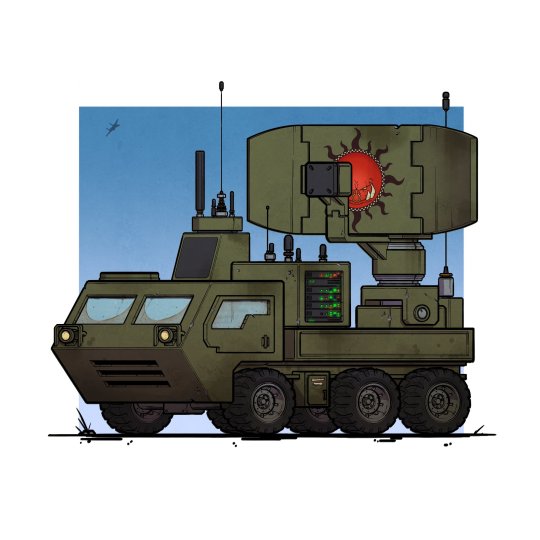
Keep an eye on the sky...
#truck#trukk#radar#air defense#early warning radar#anti air#electronic warfare#ew#military#military vehicle
37 notes
·
View notes
Text

North American T-28D "Zorro" Of 606ACS At Nakhon Phanom.
➤➤ T-28 And A Look Back At Covert Operations: https://youtu.be/X1M4snpr5YQ
➤➤ HD Image: https://tinyurl.com/532yd6vn
#youtube#aircraft#airplane#aviation#dronescapes#military#ww2#wwii#documentary#aviation history#laos#vietnam veteran#vietnam#vietnam war#covert operations#cia#black ops#air defense#air america#aviation industry#aviation photography#North American#cold war
25 notes
·
View notes
Text

#israel#air defense#coalition#international support#sympathy#gaza war#palestinians#humanitarian catastrophe#military#interception#minor damage#wounded#u.s. central command#american forces#region#iran#jordan#pro-palestinian#self-defense
14 notes
·
View notes
Text
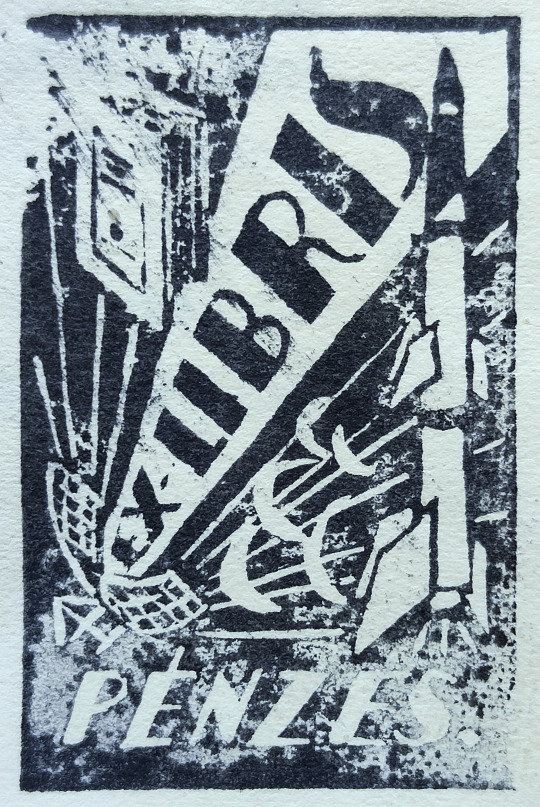
Ex libris -- Pénzes.
18 notes
·
View notes
Text
На Київщині воїни ЗСУ вогнем з кулемета Browning M2 знищили крилату ракету рашистів
21 березня 2024 року, під час масованого ракетного обстрілу російськими нацистами території України, мобільна вогнева група Сухопутних військ Збройних Сил України вогнем з кулемета Browning M2 знищила крилату ракету рашистів.
_________
On March 21, 2024, with help of the Browning M2 machine gun, soldiers of the Armed Forces of Ukraine shot down a russian cruise missile in the Kyiv…

View On WordPress
#Air defense#Armed Forces of Ukraine#ЗСУ#Збройні Сили України#Протиповітряна оборона#Російське вторгнення в Україну#Російсько-українська війна#Mobile fire group#Russo-Ukrainian War
2 notes
·
View notes
Text
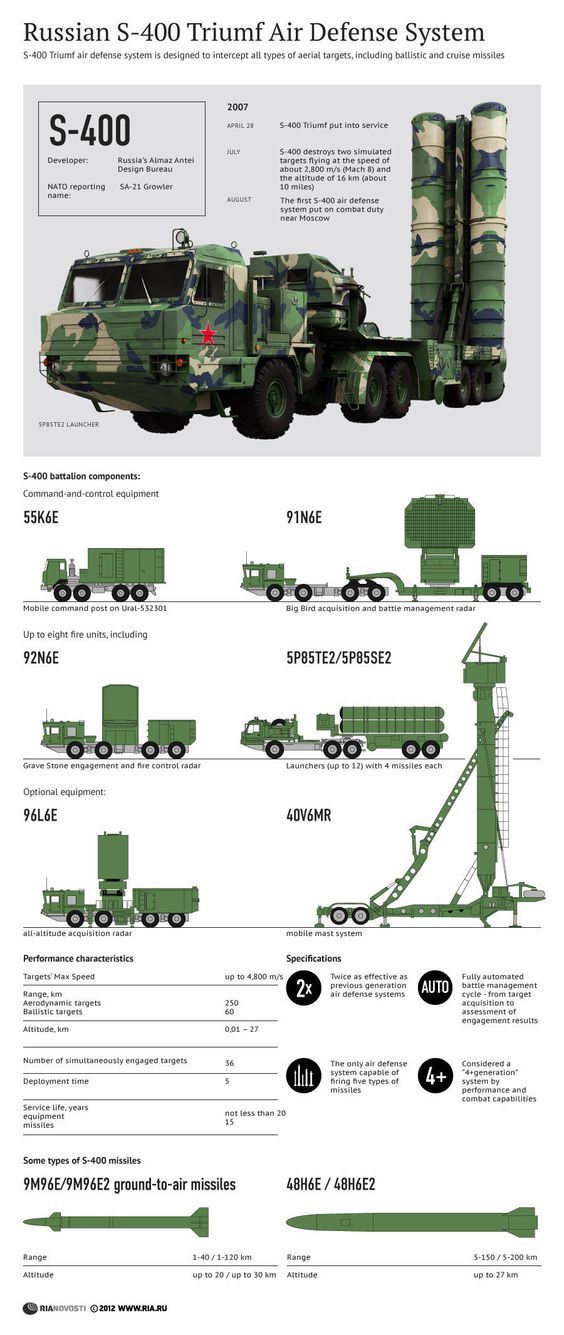
S-400
23 notes
·
View notes
Link
The US State Department has approved the potential sale of Terminal High Altitude Area Defense system missiles, THAAD fire control and communication stations, and related equipment to the United Arab Emirates, Reuters reported this week. In addition, the "State Department has approved the potential sale of Patriot missiles and related equipment to Saudi Arabia in a deal valued at up to $3.05 billion," the Pentagon said on Tuesday.
These are big deals, both in financial and strategic terms. The deal with the UAE is worth $2.25 billion, the Pentagon said. The news comes the same day as reports saying the US Army had recently tested Iron Dome at White Sands, and this just a month after the Marine Corps also tested the missile interceptor at the military testing area in New Mexico.
While these appear to be two different stories – American air defense sales to the Gulf and Israeli air defense technology being tested by the US – they are, in fact, related air defense stories.
The creation of multi-layered air defense, which Israel has pioneered, matters now more than ever. The Israel Missile Defense Organization (IMDO) in the Directorate of Defense Research and Development leads the development of Israel's multi-tiered air defense array, based on four operational layers: Iron Dome, David's Sling, Arrow 2 and Arrow 3.
7 notes
·
View notes
Text
INS Vikramaditya the First Indian Aircraft Carrier to Get Operational by the End of January 2023

INS Vikramaditya, India’s first aircraft carrier is going to join the Karwar Naval base by the end of January 2023. Prime Minister Narendra Modi is going to address in March the Combined Commanders Conference, where the hulk of battleship will be the center of attention. Sea trials will begin soon along with that for INS Vikrant, its successor leaving an impact in the Indo-Pacific waters. INS Vikramaditya is weaponized with Russian MiG-29K fighters onboard.
As for INS Vikrant, a landing of maritime LCA and test case scenario is also being considered this year. With US F-18 and French Rafale-M, a decision to bring forth 8 trainers and 26 maritime strike fighters for INS Vikrant will also take place. The Indian Navi submitted to the Defence Ministry the trial reports for the two operational aircraft carriers. The Modi government will assess the performance of the battleships and then finalize its call.
Both the carriers will remain on the western coast of India until the huge war machines find a place on a jetty at the eastern seaboard of Vishakhapatnam. But the aircraft carriers may be accommodated on a jetty at Kattupalli Port in north Chennai as the Indian Navy is planning to lease it with another jetty at Campbell Bay of Andaman and Nicobar Islands. INS Vikramaditya and INS Vikrant will empower Indian national security.
Plans are in motion as the strike forces will go well beyond the Arabian Sea and the Bay of Bengal to India-Pacific and even further. The Indian Ocean could be patrolled by three aircraft carriers of Chinese Navi by 2025, the two war machines will play in defense and deepen cooperation with PLA Navy and other major naval giants in the region.
The Indian Ocean is already being mapped by the PLA strategic surveillance vessels including the five ingress straits and 90-degree ridge to South China for maritime operations in the future. India has also been offered by Beijing naval cooperation for the littoral states surrounding the Indian Ocean. They have a proposal to gift the country off-shore patrol vessels the same that was offered to Seychelles. INS Vikramaditya and INS Vikrant will help India to secure the eastern seaboard from Africa to the Australian west coast.
Visit: - https://www.jsbmarketresearch.com/news/news-ins-vikramaditya-indian-aircraft-carrier
Follow us on social handles:-
Twitter: - https://twitter.com/JSBMarket/status/1615659928043282439?s=20&t=-ISRfa04i9qG6SKFphzuTQ
LinkedIn: - https://www.linkedin.com/posts/jsbmarketresearch_insvikramaditya-indiannavy-aircraftcarrier-activity-7021425880765730816-y0t8?utm_source=share&utm_medium=member_desktop
Pinterest: - https://pin.it/2DifLvw
Facebook: - https://www.facebook.com/profile.php?id=100088868246670
Instagram: - https://www.instagram.com/p/CnjaiJ6qLWJ/?utm_source=ig_web_copy_link
YouTube: - https://youtube.com/shorts/DoHLZehga94?feature=share
#Indian Navy#INS Vikramaditya#Aircraft Carrier#Sailing#January#Refurbished#Soviet-era Vessel#MiG-29K Fighter Jets#Air Defense#Power Projection#Karwar Base#India#jsbmarketresearch#swotanalysis#marketresearchreports
2 notes
·
View notes
Text
youtube
#youtube#militarytraining#International cooperation#Croatian soldiers#NATO#Polish soldiers#Tactical maneuvers#Military technology#War games#Missile defense#Military training#Air defense systems.#Army training#Defense#Military drills#Air defense#Live fire exercise#American soldiers#Military exercise#Anti-air missiles#Armed forces#Soldier training
0 notes
Text
EU fiddles on Middle East as Ukraine burns
The 27 leaders will seek to persuade Israel not to trigger a full-blown Middle Eastern war by attacking Iran, will make a plea to avoid a greater conflagration in Lebanon, and some European countries will push for yet more sanctions on Iran.
According to a draft of the Council conclusions, they will call for “all parties to exercise utmost restraint and refrain from any action that may increase…
View On WordPress
#air defense#benjamin netanyahu#Certification and standards#charles michel#China#Defense#drones#France#History#Iran#Israel#Joe Biden#lebanon#Middle East#military#missiles#north korea#Olaf Scholz#palestine#policy#Remedies and commitments#Russia#sanctions#Saudi Arabia#security#turkey#Ukraine#United Kingdom#United States#Volodymyr Zelenskyy
0 notes
Photo
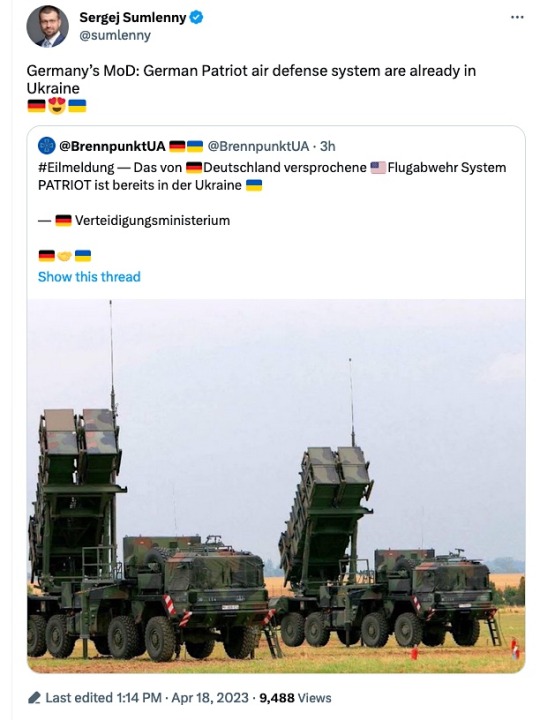
From @sumlenny
Germany’s Ministry of Defense has shipped US made PATRIOT air defense systems to Ukraine.
The mobile surface-to-air Patriot missiles are among the most advanced air defense systems available. Incoming cruise missiles, ballistic missiles, and military aircraft have all had their days ruined by Patriot missiles. Depending on the type of Patriot and its use, they can have a range of between 30 and 160 kilometers.
The ministry in its press release (in German) announced that Germany has also sent additional Zetros trucks and border patrol vehicles to Ukraine.
Russia must be defeated or it will just take a short rest and then do a repeat when it has replenished itself.
Russia is already in violation of three treaties plus the United Nations charter. It’s plain stupid to think that yet another treaty with Russia would mean “peace in our time”.
Retired US Army Gen. David Petraeus told Vazha Tavberidze at RFE/RL:
[T]his is very much an ongoing war, and it requires continued support, continued determination not just on the part of the Ukrainians but on the part of those who are helping them in what I think is about as clear a right-versus-wrong as we've seen in our lifetime: a dictatorial, kleptocratic regime denying the right of its neighbor to even exist, invading and doing so without provocation and in a particularly brutal manner, with a…culture of committing war crimes rather than preventing them and dealing with them when inevitably they might take place;
Agreed. As with World War II, there is no room for bothsiderism in this conflict. Just because Putin doesn’t have a silly mustache doesn’t mean he isn’t like Hitler.
#invasion of ukraine#patriot missiles#air defense#military aid for ukraine#germany#defeat russia#vladimir putin#russia's war of aggression#genocide#right-versus-wrong#david petraeus#tankies fuck off!#германия#ракетная система патриот#владимир путин#россия#агрессивная война россии#россия проигрывает войну#руки прочь от украины!#путин – это лжедмитрий iv а не пётр великий#союз постсоветских клептократических ватников#геноцид#путин - военный преступник#путин хуйло#геть з україни#вторгнення оркостану в україну#україна переможе#слава україні!#героям слава!
17 notes
·
View notes
Text
Three Lincoln Laboratory inventions named IEEE Milestones
New Post has been published on https://thedigitalinsider.com/three-lincoln-laboratory-inventions-named-ieee-milestones/
Three Lincoln Laboratory inventions named IEEE Milestones
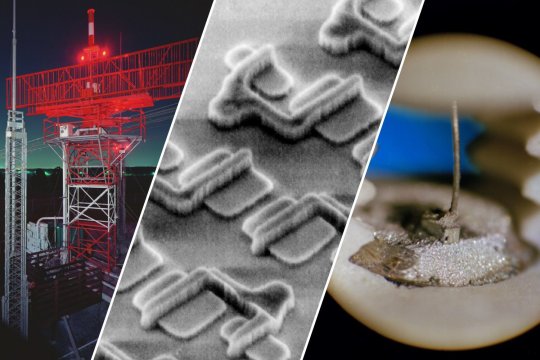

The Institute of Electrical and Electronics Engineers (IEEE) designated three historical MIT Lincoln Laboratory technologies as IEEE Milestones. The technologies are the Mode S air traffic control (ATC) radar beacon system, 193-nanometer (nm) photolithography, and the semiconductor laser. The latter recognition is shared by Lincoln Laboratory, General Electric, and IBM.
As the world’s largest technical professional organization, the IEEE’s mission is to “advance technology for the benefit of humanity.” The Milestone program commemorates innovations developed at least 25 years ago that have done just that.
All three technologies are integral to everyday life. Anyone who has flown on commercial aircraft has benefited from Mode S, the system that air traffic controllers use to track planes. The integrated circuits that power modern computing and communication devices were manufactured using 193 nm photolithography. Perhaps most ubiquitous of all is the semiconductor laser — a micrometer-sized light-emitting device that has made possible high-speed internet, among many other technologies underpinning today’s information society.
“MIT Lincoln Laboratory has been a leader in fostering innovations that were previously only considered possible in science fiction. The three IEEE Milestones presented are a testament to those accomplishments and a celebration of the diversity of ingenuity and teamwork that created these game-changing technologies,” says Karen Panetta, vice chair of IEEE Boston Section, which presented the awards to Lincoln Laboratory at a ceremony on Feb. 2.
Lincoln Laboratory holds three previous IEEE Milestones for pioneering the use of packet networks for speech communications, for developing the nation’s first air defense system, and for creating the Whirlwind high-speed digital computer in collaboration with MIT campus.
Tracking aircraft globally
The Mode S ATC radar beacon system was developed to address the challenges posed to the existing ATC beacon-radar system used in the late 1960s. Commercial air traffic was growing quickly, causing interference between beacon replies and interrogations from ATC ground radars. This interference threatened to disrupt aircraft surveillance in high-density airspace.
Under Federal Aviation Administration (FAA) sponsorship, Lincoln Laboratory led the technology developments necessary to address this safety issue. The advanced communication architecture of Mode S allowed radars to select a specific aircraft to interrogate. To selectively communicate, the system design included improved aircraft transponders, each assigned a unique address code. Upgrades to radar antennas and signal processing also allowed Mode S to accurately determine airplane position with far fewer air-to-ground messages than required by prior systems. Mode S also provided a datalink capability that enabled other key safety systems, such as the Traffic Alert and Collision Avoidance System.
Today, Mode S is a worldwide industry standard. An estimated 100,000 aircraft are equipped with Mode S transponders, and more than 900 Mode S radars are deployed across the globe. The technology is also the foundation for the FAA’s newest ATC surveillance system, which allows continuous flight tracking independent of ground radars by using aircraft-broadcast position and velocity information.
“This technology touches everybody who flies, every time they fly, for the entire duration of their flight,” says Wesley Olson, a group leader in the laboratory’s Homeland Protection and Air Traffic Control Division, where Mode S was first envisioned. “If it wasn’t for Mode S, we would have a very different air transportation system today, one that would be far less efficient and far less safe.”
Powering the microelectronics industry
The 193 nm projection photolithography technique has enabled the fabrication of every chip in every laptop, smartphone, military system, and data center for the past 20 years.
Photolithography uses light to print tiny patterns onto a silicon chip. The patterns are projected over a silicon wafer, which is coated with a chemical that changes its solubility when exposed to light. The soluble parts are etched out, leaving behind tiny structures that become the transistors and other devices on the chip.
Shorter wavelengths of light allow for printing smaller features, enabling more densely packed chips. By the 1980s, the accepted wisdom in the industry was that 248 nm was the shortest wavelength possible for photolithography.
Despite widespread skepticism and technical obstacles, Lincoln Laboratory pioneered photolithography at the 193 nm wavelength, fabricating the world’s first microelectronic devices using the technique. The first-ever 193 nm projection system was installed at the laboratory in 1993. Soon after, the laboratory opened its doors to industrial partners to guide 193 nm semiconductor manufacturing and pave the way toward its widespread adoption. Today, it is the industry’s mainstream technique and has enabled increasingly powerful integrated circuits.
“Photolithography at 193 nm has enabled the microelectronics industry to continue its path of miniaturization as charted by Moore’s law, thus impacting every aspect of our increasingly digital lives. It is also a prime example of the impact that close collaborations between Lincoln Laboratory and industrial partners have had on society,” says Mordechai Rothschild, who was one of the key developers of the 193 nm technique and today is a principal staff member in the Advanced Technology Division.
Lighting up a world of new technologies
In fall 1962, General Electric, IBM, and Lincoln Laboratory each independently reported the first demonstrations of the semiconductor laser. In the 62 years since, it has become the most widespread laser in the world and a foundational element in a vast range of technologies: DVDs, CDs, computer mice, laser pointers, barcode scanners, medical imagers, and printers, to name a few. However, its greatest impact is arguably in communications. Every second, a semiconductor laser encodes information onto light that is transmitted through fiber-optic cables across oceans and into many homes, forming the backbone of the internet.
While lasers were invented a few years earlier in 1960, the semiconductor type was exceptional because it realized all laser elements — light generation and amplification, lenses, and mirrors — within a piece of semiconducting material no bigger than a grain of rice. When injected with electrical current, the material is extremely efficient at converting the electrical energy to light. These attributes attracted the imagination of scientists and engineers worldwide.
“I’m pretty sure that we wouldn’t be streaming movies to our homes or searching for the best restaurants from our phones without the low cost and manufacturability of semiconductor lasers,” says Paul Juodawlkis, an expert in photonic devices and integrated circuits, and leader of the laboratory’s Quantum Information and Integrated Nanosystems Group. “It’s great to know that Lincoln Laboratory has played an important role in advancing this technology for government and commercial applications for the past 60-plus years and is poised to continue doing so in the future.”
Honoring inventors and their legacy
The 2024 IEEE President-elect Kathleen Kramer presented the three awards to Lincoln Laboratory Director Eric Evans during the dedication ceremony. The ceremony was held in the auditorium at Lincoln Laboratory in Lexington, Massachusetts. Evans was joined on stage by inventors or their descendants to receive each plaque. Many Lincoln Laboratory staff and retirees who contributed to these innovations were also in attendance.
Vincent Orlando, who devoted his 50-year career at the laboratory to developing Mode S technology, joined Evans to accept that award. Mordechai Rothschild and David Shaver unveiled the 193 nm photolithography plaque. Both were lead developers of that technology.
For some, the ceremony was a touching celebration of their parent’s legacy, and a return to fond memories. Richard Rediker, a son of semiconductor laser inventor Robert Rediker, recalled playing in a lab as a child with his father more than 60 years ago, the last time he visited Lincoln Laboratory. He accepted the semiconductor plaque alongside Susan Zeiger and Robert Lax, children of co-inventors Herbert Zeiger and Benjamin Lax respectively.
“It was so rewarding to meet the other children of my father’s colleagues and to fully appreciate what the inventions of our fathers mean to society today. Although my father passed away five years ago, this ceremony brought him back to life for an afternoon,” says Rediker, adding that it was an experience he will never forget.
Likewise, these technologies have left an indelible mark on the world.
“By celebrating the pride and prestige of our profession’s contributions to history, we demonstrate how engineers, scientists, and technologists have contributed not only to our local communities, but also to our global community,” Kramer said, before presenting the plaques. “It is my pleasure to recognize these pioneering events and people behind them. They serve as landmarks in the progress of technology and civilization.”
#000#1980s#2024#Administration#air#air defense#Air traffic#aircraft#applications#architecture#aviation#Awards#honors and fellowships#cables#career#chemical#Children#chips#code#Collaboration#communication#communications#Community#computer#computing#continuous#data#Data Center#defense#Design
0 notes
Video
youtube
Aircraft turrets and defense tactics. Interesting historical facts you might not know. Ep. 1 ➤➤ VIDEO ➤➤ https://youtu.be/fVjLnjvzWJo #Gunners #turret #Defense #WWII #WW2 #aviation #aviationdaily #history #B17
#youtube#b-17#b-17 flying fortress#gun turret#rear gunner#wwii#ww2#aviation#air defense#wwii history#ww2 history#engineering
3 notes
·
View notes

